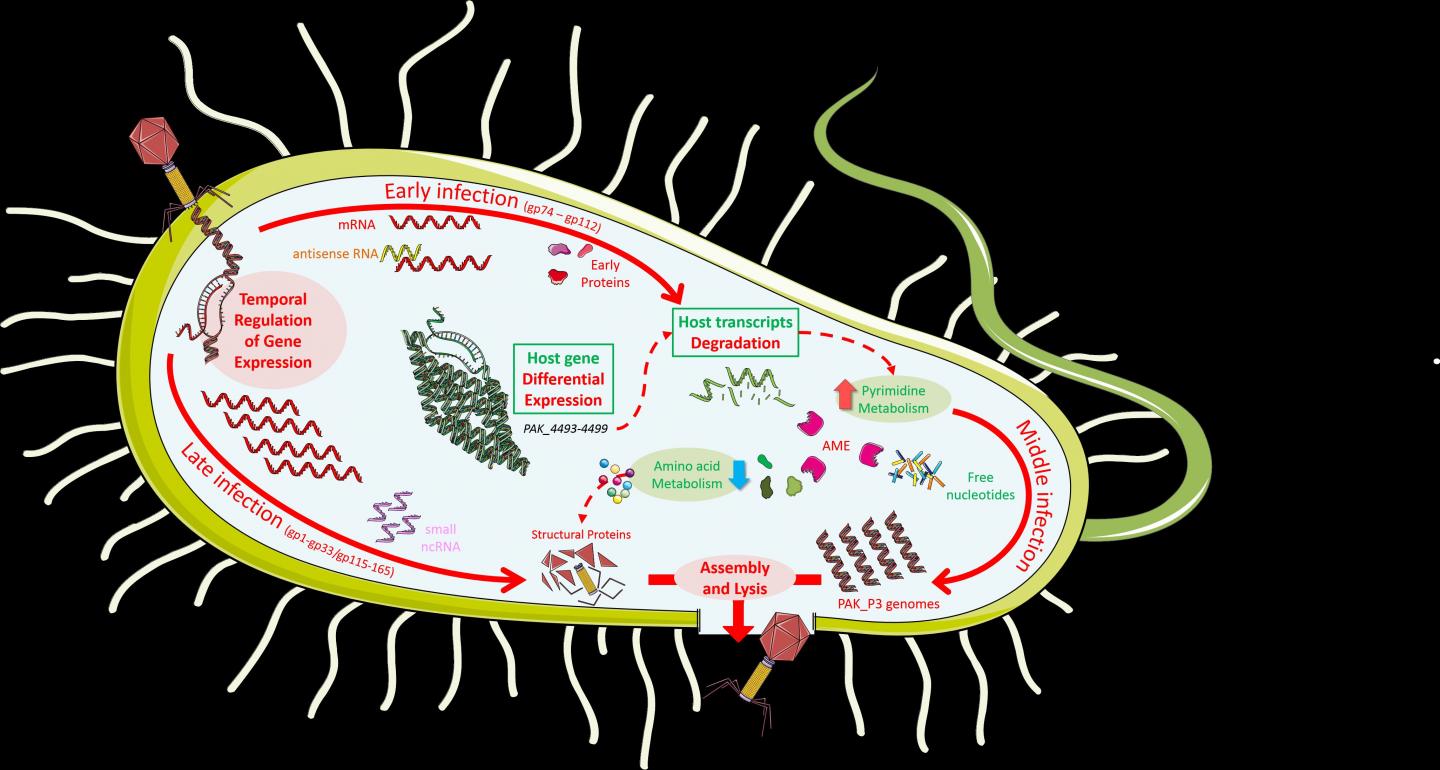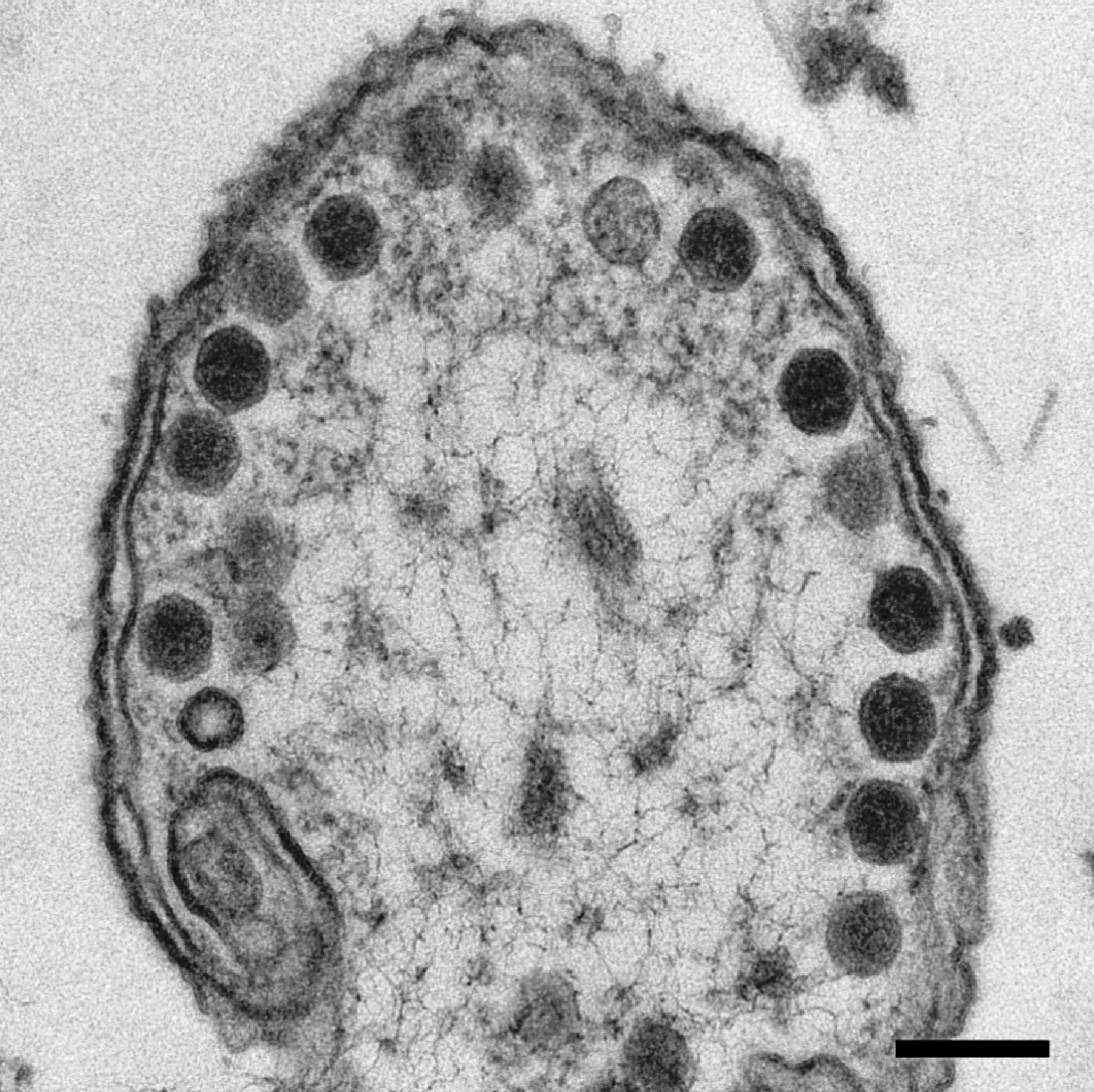Myovirus on:
[Wikipedia]
[Google]
[Amazon]
''Myoviridae'' is a family of bacteriophages in the order ''
 Viruses in ''Myoviridae'' are non-enveloped, with head-tail (with a neck) geometries. Genomes are linear, double-stranded DNA, around 33-244kb in length. The genome codes for 40 to 415 proteins. It has terminally redundant sequences. The GC-content is ~35%. The genome encodes 200-300 proteins that are transcribed in operons. 5-Hydroxymethylcytosine may be present in the genome (instead of
Viruses in ''Myoviridae'' are non-enveloped, with head-tail (with a neck) geometries. Genomes are linear, double-stranded DNA, around 33-244kb in length. The genome codes for 40 to 415 proteins. It has terminally redundant sequences. The GC-content is ~35%. The genome encodes 200-300 proteins that are transcribed in operons. 5-Hydroxymethylcytosine may be present in the genome (instead of

 On attaching to a host cell, the virus uses its contractile sheath like a syringe, piercing the cell wall with its central tube and injecting the genetic material into the host. The injected DNA takes over the host cell's mechanisms for
On attaching to a host cell, the virus uses its contractile sheath like a syringe, piercing the cell wall with its central tube and injecting the genetic material into the host. The injected DNA takes over the host cell's mechanisms for
Viralzone: Myoviridae
ICTV
Complete Genomes of Myoviridae
Virus families {{Italictitle
Caudovirales
''Caudovirales'' is an order of viruses known as the tailed bacteriophages (''cauda'' is Latin for "tail"). Under the Baltimore classification scheme, the ''Caudovirales'' are group I viruses as they have double stranded DNA (dsDNA) genomes ...
''. Bacteria
Bacteria (; singular: bacterium) are ubiquitous, mostly free-living organisms often consisting of one Cell (biology), biological cell. They constitute a large domain (biology), domain of prokaryotic microorganisms. Typically a few micrometr ...
and archaea serve as natural hosts. There are 625 species in this family, assigned to eight subfamilies and 217 genera.
Subdivisions
The subfamily ''Tevenvirinae'' (synonym: ''Tequatrovirinae'') is named after itstype species
In zoological nomenclature, a type species (''species typica'') is the species name with which the name of a genus or subgenus is considered to be permanently taxonomically associated, i.e., the species that contains the biological type specime ...
''Enterobacteria phage T4
Escherichia virus T4 is a species of bacteriophages that infect ''Escherichia coli'' bacteria. It is a double-stranded DNA virus in the subfamily ''Tevenvirinae'' from the family Myoviridae. T4 is capable of undergoing only a lytic lifecycle ...
''. Members of this subfamily are morphologically indistinguishable and have moderately elongated heads of about 110 nanometers (nm) in length, 114 nm long tails with a collar, base plates with short spikes and six long kinked tail fibers. The genera within this subfamily are divided on the basis of head morphology with the genus ''Tequatrovirus'' (Provisional name: ''T4virus'') having a head length of 137 nm and those in the genus ''Schizot4virus'' being 111 nm in length. Within the genera on the basis of protein homology the species have been divided into a number of groups.
The subfamily ''Peduovirinae'' have virions with heads of 60 nm in diameter and tails of 135 × 18 nm. These phages are easily identified because contracted sheaths tend to slide off the tail core. The P" phage is the type species.
The subfamily ''Spounavirinae'' are all virulent, broad-host range phages that infect members of the ''Bacillota
The Bacillota (synonym Firmicutes) are a phylum of bacteria, most of which have gram-positive cell wall structure. The renaming of phyla such as Firmicutes in 2021 remains controversial among microbiologists, many of whom continue to use the earl ...
''. They possess isometric heads of 87-94 nm in diameter and conspicuous capsomers, striated 140-219 nm long tails and a double base plate. At the tail tip are globular structures now known to be the base plate spikes and short kinked tail fibers with six-fold symmetry. Members of this group usually possess large (127–142 kb) nonpermuted genomes with 3.1–20 kb terminal redundancies. The name for this subfamily is derived from SPO plus ''una'' (Latin for one).
The haloviruses HF1 and HF2 belong to the same genus but since they infect archaea rather than bacteria are likely to be placed in a separate genus once their classification has been settled.
A dwarf group has been proposed on morphological and genomic grounds. This group includes the phages Aeromonas salmonicida phage 56, Vibrio cholerae phages 138 and CP-T1, Bdellovibrio phage φ1422 and Pectobacterium carotovorum phage ZF40. Their shared characteristics include an identical virion morphology, characterized by usually short contractile tails and all have genome sizes of approximately 45 kilobases. The gene order in the structural unit of the genome is in the order: terminase—portal—head—tail—base plate—tail fibers.
Virology
 Viruses in ''Myoviridae'' are non-enveloped, with head-tail (with a neck) geometries. Genomes are linear, double-stranded DNA, around 33-244kb in length. The genome codes for 40 to 415 proteins. It has terminally redundant sequences. The GC-content is ~35%. The genome encodes 200-300 proteins that are transcribed in operons. 5-Hydroxymethylcytosine may be present in the genome (instead of
Viruses in ''Myoviridae'' are non-enveloped, with head-tail (with a neck) geometries. Genomes are linear, double-stranded DNA, around 33-244kb in length. The genome codes for 40 to 415 proteins. It has terminally redundant sequences. The GC-content is ~35%. The genome encodes 200-300 proteins that are transcribed in operons. 5-Hydroxymethylcytosine may be present in the genome (instead of thymidine
Thymidine (symbol dT or dThd), also known as deoxythymidine, deoxyribosylthymine, or thymine deoxyriboside, is a pyrimidine deoxynucleoside. Deoxythymidine is the DNA nucleoside T, which pairs with deoxyadenosine (A) in double-stranded DNA. ...
).
The tubular tail has helical symmetry and is 16-20 nm in diameter. It consists of a central tube, a contractile sheath, a collar, a base plate, six tail pins and six long fibers. It is similar to '' Tectiviridae'', but differs in the fact that a myovirus' tail is permanent.
Contractions of the tail require ATP. On contraction of the sheath, sheath subunits slide over each other and the tail shortens to 10–15 nm in length.
Life cycle

 On attaching to a host cell, the virus uses its contractile sheath like a syringe, piercing the cell wall with its central tube and injecting the genetic material into the host. The injected DNA takes over the host cell's mechanisms for
On attaching to a host cell, the virus uses its contractile sheath like a syringe, piercing the cell wall with its central tube and injecting the genetic material into the host. The injected DNA takes over the host cell's mechanisms for transcription
Transcription refers to the process of converting sounds (voice, music etc.) into letters or musical notes, or producing a copy of something in another medium, including:
Genetics
* Transcription (biology), the copying of DNA into RNA, the fir ...
and translation
Translation is the communication of the meaning of a source-language text by means of an equivalent target-language text. The English language draws a terminological distinction (which does not exist in every language) between ''transla ...
and begins to manufacture new viruses. Replication follows the replicative transposition model. DNA-templated transcription is the method of transcription. Translation takes place by -1 ribosomal frameshifting. The virus exits the host cell by lysis, and holin
Holins are a diverse group of small proteins produced by dsDNA bacteriophages in order to trigger and control the degradation of the host's cell wall at the end of the lytic cycle. Holins form pores in the host's cell membrane, allowing lysins t ...
/endolysin
Lysins, also known as endolysins or murein hydrolases, are hydrolytic enzymes produced by bacteriophages in order to cleave the host's cell wall during the final stage of the lytic cycle. Lysins are highly evolved enzymes that are able to target ...
/ spanin proteins.
Bacteria
Bacteria (; singular: bacterium) are ubiquitous, mostly free-living organisms often consisting of one Cell (biology), biological cell. They constitute a large domain (biology), domain of prokaryotic microorganisms. Typically a few micrometr ...
and archaea serve as the natural host. Transmission route is passive diffusion
Diffusion is the net movement of anything (for example, atoms, ions, molecules, energy) generally from a region of higher concentration to a region of lower concentration. Diffusion is driven by a gradient in Gibbs free energy or chemica ...
.
Although Myoviruses are in general lytic
The lytic cycle ( ) is one of the two cycles of viral reproduction (referring to bacterial viruses or bacteriophages), the other being the lysogenic cycle. The lytic cycle results in the destruction of the infected cell and its membrane. Bacter ...
, lacking the genes required to become lysogenic
Lysogeny, or the lysogenic cycle, is one of two cycles of viral reproduction (the lytic cycle being the other). Lysogeny is characterized by integration of the bacteriophage nucleic acid into the host bacterium's genome or formation of a circu ...
, a number of temperate
In geography, the temperate climates of Earth occur in the middle latitudes (23.5° to 66.5° N/S of Equator), which span between the tropics and the polar regions of Earth. These zones generally have wider temperature ranges throughout ...
species are known.
Applications
Because most ''Myoviridae'' are lytic, rather than temperate, phages, some researchers have investigated their use as a therapy for bacterial diseases in humans and other animals.Taxonomy
The following eight subfamilies are recognized: *'' Emmerichvirinae'' *'' Eucampyvirinae'' *'' Gorgonvirinae'' *'' Ounavirinae'' *'' Peduovirinae'' *'' Tevenvirinae'' *'' Twarogvirinae'' *'' Vequintavirinae'' Additionally, the following genera are unassigned to a subfamily: *'' Abouovirus'' *'' Acionnavirus'' *'' Agricanvirus'' *'' Ahtivirus'' *'' Alcyoneusvirus'' *'' Alexandravirus'' *'' Anamdongvirus'' *'' Anaposvirus'' *'' Aokuangvirus'' *'' Asteriusvirus'' *'' Atlauavirus'' *'' Aurunvirus'' *'' Ayohtrevirus'' *'' Baikalvirus'' *'' Bakolyvirus'' *'' Barbavirus'' *'' Bcepfunavirus'' *'' Bcepmuvirus'' *'' Becedseptimavirus'' *'' Bellamyvirus'' *'' Bendigovirus'' *'' Biquartavirus'' *'' Bixzunavirus'' *'' Borockvirus'' *'' Brigitvirus'' *'' Brizovirus'' *'' Brunovirus'' *'' Busanvirus'' *'' Carpasinavirus'' *'' Chakrabartyvirus'' *'' Charybdisvirus'' *'' Chiangmaivirus'' *'' Colneyvirus'' *'' Cymopoleiavirus'' *'' Derbicusvirus'' *'' Dibbivirus'' *'' Donellivirus'' *'' Elmenteitavirus'' *'' Elvirus'' *'' Emdodecavirus'' *'' Eneladusvirus'' *'' Eponavirus'' *'' Erskinevirus'' *'' Eurybiavirus'' *'' Ficleduovirus'' *'' Flaumdravirus'' *'' Fukuivirus'' *'' Gofduovirus'' *'' Goslarvirus'' *'' Haloferacalesvirus'' *'' Hapunavirus'' *'' Heilongjiangvirus'' *'' Iapetusvirus'' *'' Iodovirus'' *'' Ionavirus'' *'' Jedunavirus'' *'' Jilinvirus'' *'' Jimmervirus'' *'' Kanagawavirus'' *'' Kanaloavirus'' *'' Klausavirus'' *'' Kleczkowskavirus'' *'' Kungbxnavirus'' *'' Kylevirus'' *'' Lagaffevirus'' *'' Leucotheavirus'' *'' Libanvirus'' *'' Lietduovirus'' *'' Llyrvirus'' *'' Loughboroughvirus'' *'' Lubbockvirus'' *'' Machinavirus'' *'' Marfavirus'' *'' Marthavirus'' *'' Mazuvirus'' *'' Menderavirus'' *'' Metrivirus'' *'' Mieseafarmvirus'' *'' Mimasvirus'' *'' Moabitevirus'' *'' Moturavirus'' *'' Muldoonvirus'' *'' Mushuvirus'' *'' Muvirus'' *'' Myoalterovirus'' *''Myohalovirus
''Myohalovirus'' (synonym: ''PhiH-like viruses'', ''Phihlikevirus'') is a genus of viruses in the order ''Caudovirales'', in the family ''Myoviridae''. Bacteria and archaea serve as natural hosts. There are three species in this genus.
Taxonomy ...
''
*'' Myosmarvirus''
*'' Naesvirus''
*'' Namakavirus''
*'' Nankokuvirus''
*'' Neptunevirus''
*'' Nereusvirus''
*'' Nerrivikvirus''
*'' Nodensvirus''
*'' Noxifervirus''
*'' Nylescharonvirus''
*'' Obolenskvirus''
*'' Otagovirus''
*'' Pakpunavirus''
*'' Palaemonvirus''
*'' Pbunavirus''
*'' Peatvirus''
*'' Pemunavirus''
*'' Petsuvirus''
*'' Phabquatrovirus''
*'' Phapecoctavirus''
*'' Phikzvirus''
*'' Pippivirus''
*'' Plaisancevirus''
*'' Plateaulakevirus''
*'' Polybotosvirus''
*'' Pontusvirus''
*'' Popoffvirus''
*'' Punavirus''
*'' Qingdaovirus''
*'' Rahariannevirus''
*'' Radnorvirus''
*'' Ripduovirus''
*'' Risingsunvirus''
*'' Ronodorvirus''
*'' Rosemountvirus''
*'' Saclayvirus''
*'' Saintgironsvirus''
*'' Salacisavirus''
*'' Salmondvirus''
*'' Sarumanvirus''
*'' Sasquatchvirus''
*'' Schmittlotzvirus''
*'' Seoulvirus''
*'' Shandongvirus''
*'' Sherbrookevirus''
*'' Shirahamavirus''
*'' Shalavirus''
*'' Svunavirus''
*'' Tabernariusvirus''
*'' Takahashivirus''
*'' Tamkungvirus''
*'' Taranisvirus''
*'' Tefnutvirus''
*'' Tegunavirus''
*'' Thaumasvirus''
*'' Thetisvirus''
*'' Thornevirus''
*'' Tijeunavirus''
*'' Toutatisvirus''
*'' Tulanevirus''
*'' Vellamovirus''
*'' Vhmlvirus''
*'' Vibakivirus''
*'' Wellingtonvirus''
*'' Wifcevirus''
*'' Winklervirus''
*'' Yokohamavirus''
*'' Yoloswagvirus''
*'' Yongloolinvirus''
References
External links
Viralzone: Myoviridae
ICTV
Complete Genomes of Myoviridae
Virus families {{Italictitle